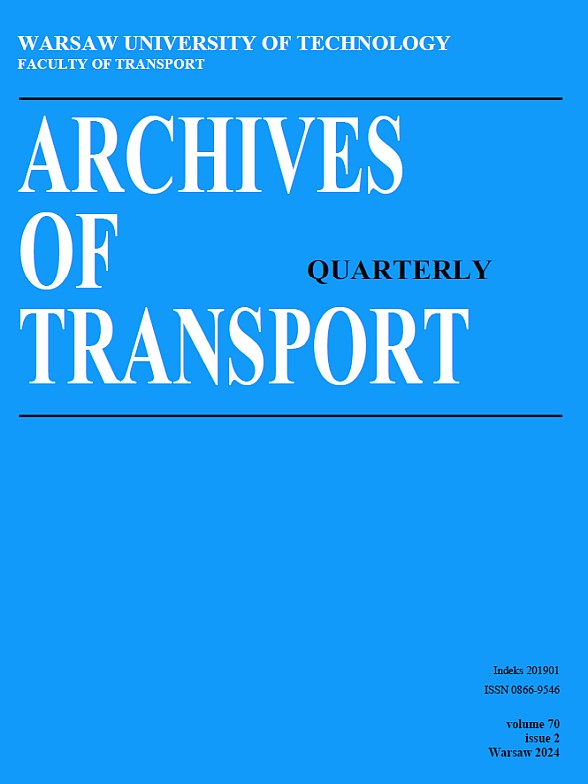Modeling of material and energy inputs in the life cycle of a vehicle
DOI:
https://doi.org/10.61089/aot2024.vzsv6b46Keywords:
mathematical model, life cycle analysis, vehicle, environmental managementAbstract
The paper focuses on the analysis of the environmental impacts related to the production, operation, decommissioning of vehicles as well as servicing and repairs of cars in real conditions of their use. The authors’ presented mathematical model that was implemented in original numerical program EN-VEHICLE that enables the analysis of energy consumption and emission loads related to material inputs in the entire life cycle of a passenger car. It is a tool from the Life Cycle Assessment category that aims at the effective inclusion of environmental impacts in the decision-making process. The developed program allows for a quantitative interpretation of the calculation results in terms of the environmental safety in each of the phases and throughout the life cycle of the vehicle, taking into account the possibility of supplying the vehicle system with additional material streams derived from recycling and recovery, and introduced both during the construction phase and during the car operation phase. In the presented tool, linear algebra and matrix analysis were used in modeling the vehicle life cycle system. The results of the implementation of the mathematical model were presented in the form of a regression function that allows for approximation of selected empirical data. The regression analysis was used to verify the material characteristics. The tool can be used for a comprehensive comparative assessment of the environmental impact of a passenger car from different production periods. In addition, it can be used to forecast the environmental effects of changes in the material structure determining the production technology and, consequently, having a significant impact on the entire life cycle of the vehicle as well as energy and ecological parameters.
References
Chanaron, J-J. (2007). Life cycle assessment practices: Benchmarking selected European Automobile Manufactures. International Journal of Product Lifecycle Management, 2(3), 290–311. https://doi.org/10.1504/IJPLM.2007.016293.
Das, S. (2011). Life cycle assessment of carbon fiber-reinforced polymer composites. International Journal of Life Cycle Assessment, 16(3), 268–282. http://dx.doi.org/10.1007/s11367-011-0264-z.
De Medina, H.V. (2006). Eco-design for materials selection in automobile industry. In: CIRP International Conference on Life Cycle Engineering, 13th, Leuven, Belgium, 299-304.
European Environment Agency. Nitrogen Oxides (Nox) Emissions. Available online: https://www.eea.europa.eu/data-and-maps/indicators/eea-32-nitrogen oxides-nox-emissions-1/assessment. 2010-08-19.0140149032-3 (accessed on 25 October 2021).
Finkbeiner, M., Hoffmann, R., Ruhland, K., Liebhart, D., & Stark, B. (2006). Application of Life Cycle Assessment for the Environmental Certificate of the Mercedes-Benz S-Class. International Journal of Life Cycle Assessment, 11(4), 240–246.
Gradin, K.T., & Åström, A.H. (2020). Comparative life cycle assessment of car disc brake systems - case study results and method discussion about comparative LCAs. International Journal of Life Cycle Assessment, 25, 350–362. https://doi.org/10.1007/s11367-019-01704-9.
Gradin, K.T., Luttropp, C., & Björklund, A. (2013). Investigating improved vehicle dismantling and fragmentation technology. Journal of Cleaner Production, 54(1), 23–29. https://doi.org/10.1016/j.jclepro.2013.05.023.
Hawkins, T.R., Singh, B., Majeau-Bettez, G., & Strømman, A.H. (2013). Comparative Environmental Life Cycle Assessment of Conventional and Electric Vehicles. Journal of Industrial Ecology, 17(1), 53–64. https://doi.org/10.1111/j.1530-9290.2012.00532.x.
International Energy Agency, https://www.iea.org/data-and-statistics/charts/transport-sector-co2-emissions-by-mode-in-the-sustainable-development-scenario-2000-2030 (accessed on 25 April 2022)
International Organization for Standardization (ISO), 2006a. 14040–Environmental Management. Life Cycle Assessment. Principles and Framework.
International Organization for Standardization (ISO), 2006b. 14044–Environmental Management. Life Cycle Assessment. Requirements and Guidelines.
Klocke, F., Kampker, A., Döbbeler, B., Maue, A., & Schmieder, M. (2014). Simplified life cycle assessment of a hybrid car body part. Procedia CIRP, 15, 484–489. https://doi.org/10.1016/j.procir.2014.06.056.
Lewicki, R. (2009). End-of-life vehicles in the light of environmental benefits identified in the products life cycle. Scientific Problems of Machines Operation and Maintenance, 1(57), 87–99.
Ma, H., Balthasar, F., Tait, N., Riera-Palou, X., & Harrison, A. (2012). A new comparison between the life cycle greenhouse gas emissions of battery electric vehicles and internal combustion vehicles. Energy Policy, 44, 160–173. https://doi.org/10.1016/j.enpol.2012.01.034.
Mayyas, A., Qattawi, A., Omar, M., & Shan, D. (2012). Design for sustainability in automotive industry: A comprehensive review. Renewable and Sustainable Energy Review, 16(4), 1845–1862. https://doi.org/10.1016/j.rser.2012.01.012.
Merkisz-Guranowska, A. (2020). A comparative study on end-of-life vehicles network design. Archives of Transport, 54(2), 107-123; DOI: 10.5604/01.3001.0014.2971.
Mrozik, M., Merkisz-Guranowska, A. (2021). Environmental assessment of the vehicle operation process. Energies, 14, 76. https://dx.doi.org/10.3390/en14010076.
Nitta, S., & Moriguchi, Y. (2011). New methodology of life cycle assessment for clean energy vehicle and new car model, SAE Technical Paper 2011-01-0851. https://doi.org/10.4271/2011-01-0851.
Petrov, R., Vasilyev, M., Kabanova, O., & Kirillov, V. (2001). Comparative analysis of dismantlability for LADA Cars. SAE Technical Paper, 2001-01-3755. https://doi.org/10.4271/2001-01-3755.
Raugei, M., Morrey, D., Hutchinson, A., & Winfield, P. (2015). A coherent life cycle assessment of a range of light weighting strategies for compact vehicles. Journal of Cleaner Production, 108, 1168–1176. http://dx.doi.org/10.1016/j.jclepro.2015.05.100.
Ribeiro, C., Ferreira, J.V., & Partidário, P. (2007). Life Cycle Assessment of a multi-material car component. International Journal of Life Cycle Assessment, 12(5), 336–345. https://doi.org/10.1065/lca2006.12.304.
Schmidt, W.P., Dahlqvist, E., Finkbeiner, M., Krinke, S., Lazzari, S., Oschmann, D., et al. (2004). Life Cycle Assessment of lightweight and end-of-life scenarios for generic compact class passenger vehicles. International Journal of Life Cycle Assessment, 9(6), 405–416. https://doi.org/10.1007/BF02979084.
Suzuki, T., Odai, T., Hukui, R., & Takahashi, J. (2005). LCA of passenger vehicles lightened by recyclable carbon fiber reinforced plastics. In: Proceedings of the International Conference on Life Cycle Assessment, San Jose, Costa Rica, April 25−28, 2005. http://jt.o.oo7.jp/publications/050425.pdf.
Unece United Nations Economic Commission For Europe, Climate Change and Sustainable Transport. Available online: http://www.unece.org/?id=9890 (accessed on 26 October 2022).
Downloads
Published
Issue
Section
License
Copyright (c) 2024 Archives of Transport journal allows the author(s) to hold the copyright without restrictions.

This work is licensed under a Creative Commons Attribution 4.0 International License.










